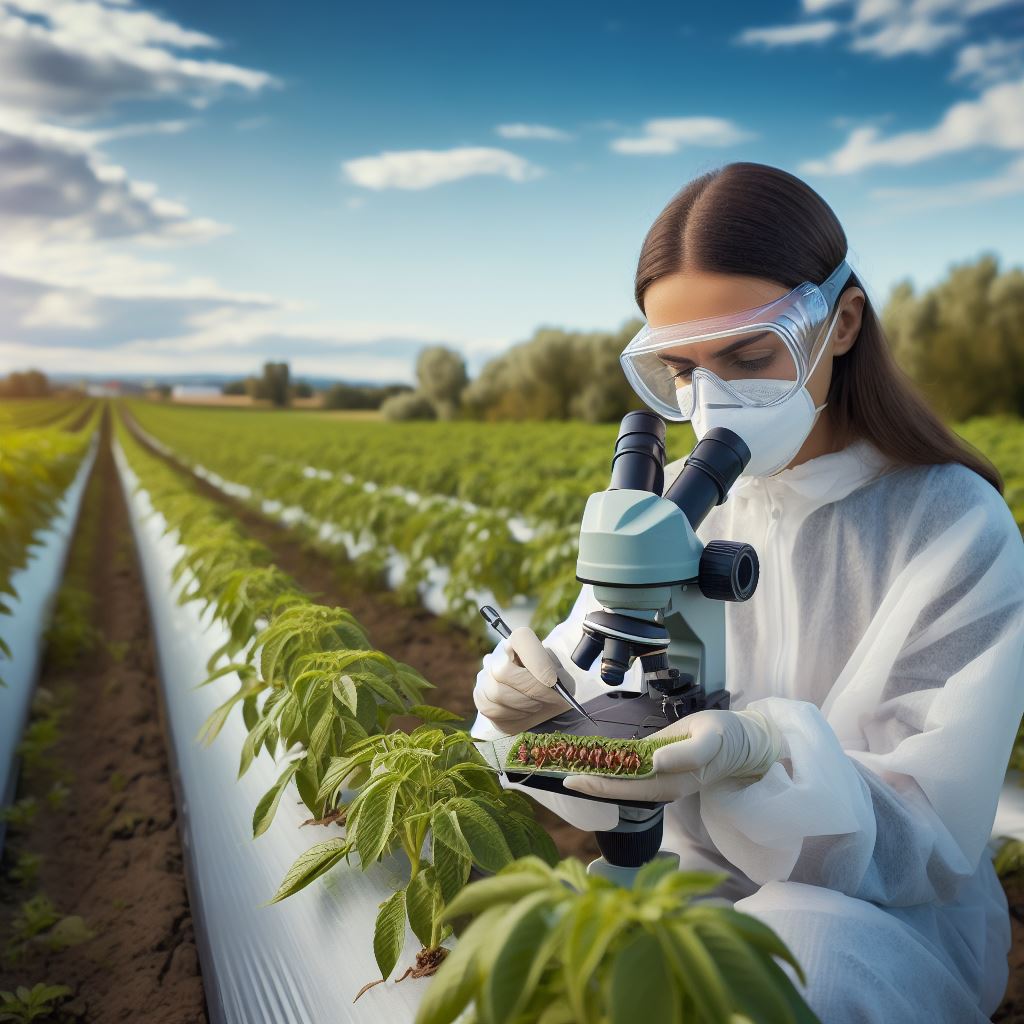The Economics of IPM in Agriculture
Last Updated on January 25, 2024
Introduction
In the world of agriculture, pest management is a constant challenge. Farmers are constantly battling against pests that can devastate their crops and reduce their yields.
Traditional approaches to pest control often involve the heavy use of chemical pesticides, which can be harmful to both the environment and human health.
This is where Integrated Pest Management (IPM) comes in.
IPM is a holistic approach to pest control that emphasizes prevention, monitoring, and the use of multiple techniques to manage pests.
It involves the integration of various strategies such as biological control, cultural practices, and the judicious use of chemical pesticides.
By combining these strategies, IPM aims to reduce the reliance on chemical pesticides and minimize their negative impacts.
The importance of IPM in agriculture cannot be overstated. First and foremost, it promotes sustainable farming practices by reducing the use of chemical pesticides.
This not only helps to protect the environment but also safeguard the health of farmers and consumers.
Furthermore, IPM can help farmers save costs as it often proves to be more cost-effective in the long run.
It also promotes biodiversity by protecting beneficial organisms that can act as natural predators to pests.
In short, IPM is a vital component of modern agriculture. By adopting this approach, farmers can effectively manage pests while reducing their reliance on chemical pesticides.
The economic and environmental benefits of IPM make it a win-win solution for both farmers and the wider ecosystem.
Economic Aspects of IPM
IPM, or Integrated Pest Management, is an agricultural approach that aims to control pests effectively while minimizing the use of chemical pesticides.
This blog section will focus on the economic aspects surrounding IPM.
Cost-benefit Analysis of IPM
One of the significant economic advantages of IPM is the reduction in pesticide use and associated costs.
Traditional pest control methods heavily rely on the application of chemical pesticides, which can be expensive.
However, IPM practices emphasize using a combination of different pest control strategies, such as biological controls and cultural practices.
By implementing IPM, farmers can reduce their reliance on pesticides, leading to cost savings.
Furthermore, IPM has the potential to increase crop yield and profits. Pests can cause significant damage to crops, resulting in lower yields and financial losses for farmers.
With IPM, farmers can identify and monitor pests’ presence more accurately, allowing for targeted pest control measures.
By effectively managing pests, crop damage can be minimized, leading to higher crop yields and increased profits.
Long-term Cost Savings with IPM
Avoidance of resistance development in pests
Prolonged and extensive use of chemical pesticides can lead to pests developing resistance, rendering these pesticides ineffective.
This poses a significant economic risk to farmers as they may need to invest in newer, more expensive pesticides.
However, by utilizing IPM strategies, farmers can minimize the selective pressure on pests, making it less likely for resistance to develop.
This ultimately translates to long-term cost savings, as farmers can continue using effective and affordable pest control methods.
Preservation of ecosystem services
IPM promotes a holistic approach that strives to maintain a balance between pest control and the preservation of ecosystem services.
Many beneficial organisms, such as pollinators and natural enemies of pests, contribute to crop productivity.
Traditional pest control methods often disregard these ecosystem services. In contrast, IPM aims to protect and enhance these services, leading to improved crop yields.
By preserving ecosystem services, farmers can reduce their reliance on costly inputs, further contributing to long-term cost savings.
In fact, implementing IPM practices in agriculture offers several economic benefits.
The cost-benefit analysis reveals reduced pesticide use and associated costs, along with the potential for increased crop yields and profits.
Furthermore, the long-term cost savings associated with IPM are seen through the avoidance of resistance development in pests and the preservation of ecosystem services.
By adopting IPM, farmers can not only achieve economic prosperity but also contribute to sustainable and environmentally-friendly agricultural practices.
Read: IPM Training: Empowering Sustainable Farmers
Economic considerations for implementing IPM
Implementing Integrated Pest Management (IPM) in agriculture requires careful evaluation of economic considerations.
This section explores both the initial investment required for IPM programs and the economic incentives for farmers to adopt IPM practices.
Initial investment in IPM programs
To successfully implement IPM, farmers need to undergo thorough training and education.
This initial investment ensures the farmers have the necessary knowledge and skills to implement IPM effectively.
Training programs may cover areas such as identifying pest problems, monitoring pest populations, and selecting appropriate control measures.
Education on the principles and benefits of IPM is also crucial to encourage farmers to embrace this approach.
In addition to training, infrastructure and equipment upgrades are often required for the successful adoption of IPM.
This investment may include improving irrigation systems, constructing pest-proof storage facilities, or acquiring specialized equipment for pest monitoring and control.
While these upgrades entail upfront costs, they contribute to the long-term economic viability of the farm by reducing the reliance on expensive chemical inputs and improving overall productivity.
Economic incentives for adopting IPM
Despite the initial investment in IPM, there are significant economic incentives for farmers to adopt this approach.
Government subsidies and grants play a crucial role in facilitating the adoption of IPM by providing financial support to farmers.
These incentives help offset the costs associated with training, infrastructure upgrades, and equipment requirements.
Governments recognize the environmental and societal benefits of IPM and are increasingly encouraging its implementation through financial assistance programs.
Another economic incentive for farmers is the potential for reduced insurance premiums.
Insurance companies recognize the lower risk associated with IPM practices as they promote sustainable pest control methods and reduce the reliance on chemical pesticides.
By employing IPM, farmers can demonstrate their commitment to environmental stewardship and risk reduction, which can result in lower insurance premiums and long-term cost savings.
In essence, the economics of implementing IPM in agriculture require careful consideration of initial investments and the potential incentives for farmers.
By investing in training and education, as well as infrastructure and equipment, farmers can successfully adopt IPM practices.
Additionally, the availability of government subsidies and grants, along with reduced insurance premiums, provides further economic incentives for farmers to embrace IPM.
Through these economic considerations, IPM can be implemented effectively, promoting sustainable and environmentally responsible agriculture.
Read: IPM: Reducing Pesticides, Boosting Yields
Market demand and IPM
Consumer preference for sustainably produced food
Consumers today are increasingly concerned about the environmental impact of food production.
They prefer sustainably produced food that protects the health of natural resources and ecosystems.
Integrated Pest Management (IPM) practices align with these preferences as they minimize the use of harmful pesticides.
IPM focuses on prevention, monitoring, and control of pests while also considering the impact on human health and the environment.
Therefore, IPM products have a significant market advantage due to consumer demand for sustainable and environmentally friendly options.
Potential for higher prices and market access for IPM products
Due to the increasing demand for sustainably produced food, IPM products have the potential for higher prices.
Consumers are often willing to pay a premium for products that align with their values and have less impact on the environment.
IPM farmers can leverage this premium pricing to improve their profitability and income.
Additionally, IPM products offer better market access, especially in regions with strict regulations regarding pesticide residues in food.
Many countries have set maximum residue limits (MRLs) for pesticides in agricultural products.
By using IPM practices, farmers can ensure their products meet these MRLs, allowing them to access broader markets.
Marketing advantages of IPM certification
Obtaining IPM certification provides marketing advantages for farmers and agricultural companies.
Certification ensures that IPM practices are followed, giving consumers confidence in the sustainability and safety of the products.
Companies can market their IPM-certified products with labels and logos that indicate their commitment to sustainable farming practices.
These certifications differentiate IPM products from conventional ones, attracting consumers who prioritize sustainable choices.
In addition to attracting environmentally conscious consumers, IPM certification can also open doors to institutional buyers.
Institutions such as schools, hospitals, and government agencies often prioritize buying sustainably produced food.
Thus, IPM certification can provide access to larger and more lucrative markets for agricultural producers.
In general, market demand for sustainably produced food has created a favorable environment for IPM products.
Consumers prefer products that align with their environmental values, and IPM practices fit the bill by minimizing pesticide use.
This consumer demand drives higher prices for IPM products, allowing farmers to increase their profitability.
Furthermore, IPM practices ensure compliance with pesticide residue regulations, enabling access to broader markets.
The marketing advantages of IPM certification, such as increased consumer confidence and access to institutional buyers, further contribute to the economic viability of IPM in agriculture.
Read: Chemical-Free IPM: Pros and Cons

Case studies on the economic benefits of IPM
In this section, we will explore two case studies that highlight the economic benefits of Integrated Pest Management (IPM) in agriculture.
These studies demonstrate how IPM can increase profitability and lead to long-term cost savings in farming practices.
Study 1: Increased profitability with IPM implementation
One of the key economic benefits of implementing IPM practices is the reduction in pesticide purchases.
Farmers who adopt IPM can significantly cut down on the amount of pesticides they need, resulting in cost savings.
By using IPM techniques such as biological control and crop rotation, farmers can target specific pests and reduce the dependence on chemical pesticides.
Additionally, the implementation of IPM practices also leads to improved crop quality, which directly impacts consumer demand.
Consumers are increasingly demanding pesticide-free and sustainable produce. By meeting these demands, farmers can command higher prices in the market, contributing to increased profitability.
Study 2: Long-term cost savings with IPM in organic farming
Organic farming, with its focus on natural and sustainable practices, can greatly benefit from IPM strategies.
In this case study, we examine the economic advantages of IPM in organic farming.
One of the significant cost savings with IPM in organic farming is the minimal pesticide input costs.
Organic farmers rely on natural pest control methods such as beneficial insects, traps, and cultural practices.
By utilizing these methods, farmers can avoid costly synthetic pesticides, reducing their overall expenses and increasing their profit margins.
Furthermore, IPM in organic farming contributes to enhanced soil health and nutrient cycling.
By promoting biodiversity and minimizing chemical inputs, IPM practices create a balanced ecosystem.
This improves soil fertility and reduces the need for expensive external inputs like fertilizers.
As a result, organic farmers practicing IPM can save on long-term costs while maintaining sustainable farming practices.
In a nutshell, these case studies highlight the economic benefits of implementing IPM in agriculture.
Whether it is reducing pesticide purchases and improving crop quality or saving costs in organic farming and enhancing soil health, IPM proves to be a valuable tool for farmers.
By adopting IPM practices, farmers can achieve increased profitability and long-term sustainability in their agricultural operations.
Read: Cultural Practices in IPM for Soil Health
Challenges and barriers to implementing IPM economically
Lack of awareness and knowledge about IPM practices
- Many farmers have limited understanding of integrated pest management (IPM) and its benefits.
- Without awareness, farmers may not implement IPM practices or understand their economic value.
- Education and training programs are needed to increase awareness and knowledge about IPM.
- Extension services and agricultural organizations play a crucial role in promoting IPM practices.
Availability of affordable IPM resources and technologies
- The cost of IPM resources and technologies can be a significant barrier to implementation.
- Farmers may be reluctant to adopt IPM if the expenses outweigh the potential benefits.
- Access to affordable pest control products, equipment, and technology is essential for successful IPM.
- Government subsidies and financial incentives can help make IPM more economically feasible for farmers.
Difficulties in quantifying economic benefits accurately
- It can be challenging to measure and quantify the economic benefits of IPM accurately.
- The benefits of IPM, such as reduced pesticide use and increased crop yields, may be intangible or long-term.
- Existing economic evaluation methods may not fully capture the true value of IPM practices.
- More research and development are needed to refine economic assessment tools for IPM.
In summary, implementing IPM economically faces several challenges and barriers that need to be addressed.
Increasing awareness and knowledge about IPM practices among farmers is crucial.
Improving the availability and affordability of IPM resources and technologies can encourage adoption.
Developing accurate methods to quantify the economic benefits of IPM will provide better incentives for farmers.
Collaboration between farmers, government, extension services, and researchers is necessary to overcome these challenges and ensure the widespread adoption of economically viable IPM practices.
Conclusion
IPM in agriculture offers numerous economic advantages, such as cost-effectiveness and increased yields.
Implementing IPM enhances crop yields. It reduces pesticide costs, preserving farmers’ financial resources.
IPM minimizes environmental impact, ensuring sustainable agriculture.
Long-term gains include soil health improvement and reduced dependence on chemical inputs.
IPM fosters a balanced ecosystem, promoting biodiversity and resilient farming practices.
Farmers should embrace IPM for holistic benefits. Adopting diverse strategies ensures effective pest management. Explore training programs for seamless integration.
IPM not only boosts economic viability but also paves the way for a greener, more sustainable agricultural future.
It is crucial for farmers to consider the long-term sustainability and profitability of their practices.
Therefore, it is highly encouraged for farmers to explore and adopt IPM practices for a more sustainable and profitable future.
Farmers are urged to explore, embrace, and champion IPM practices for enduring success.


